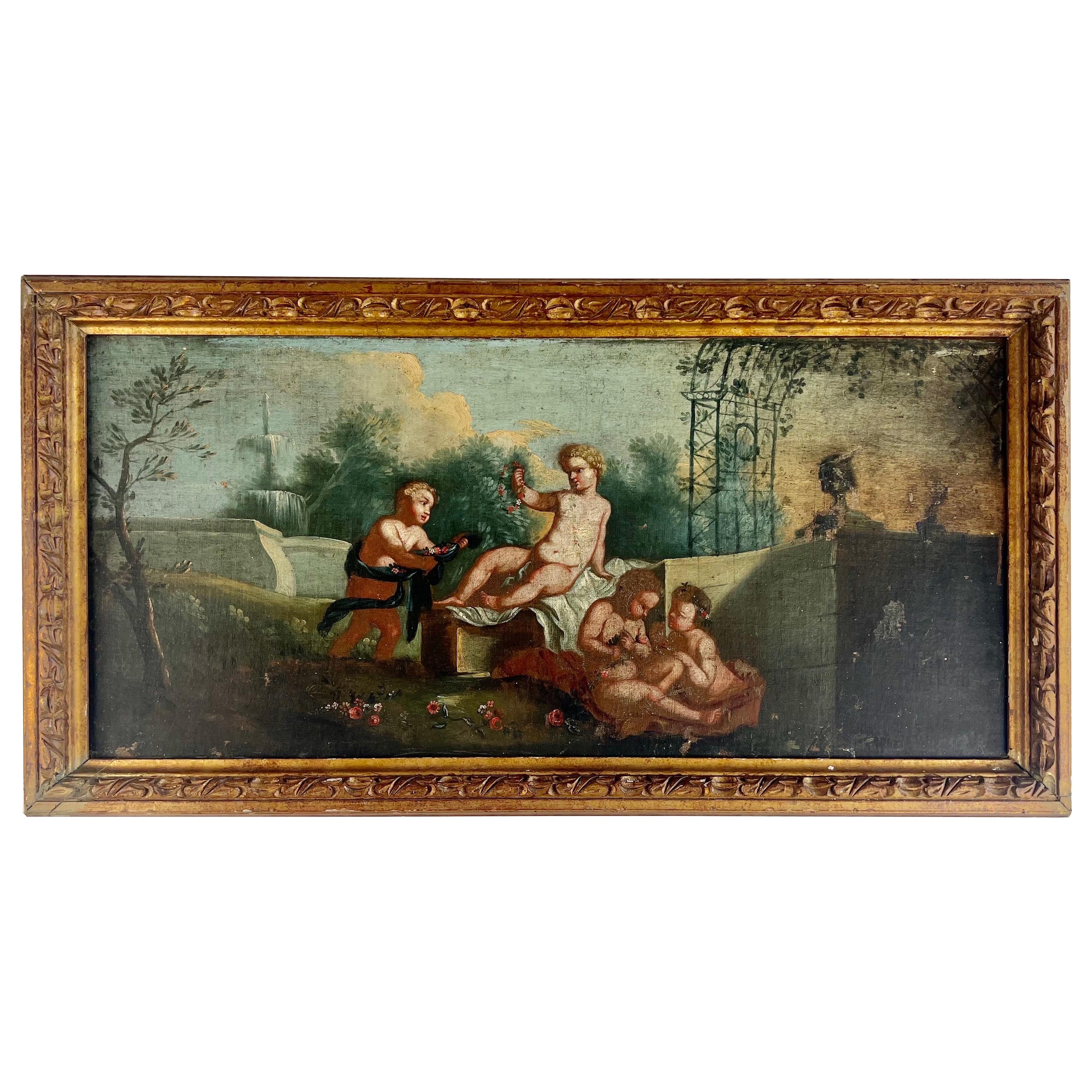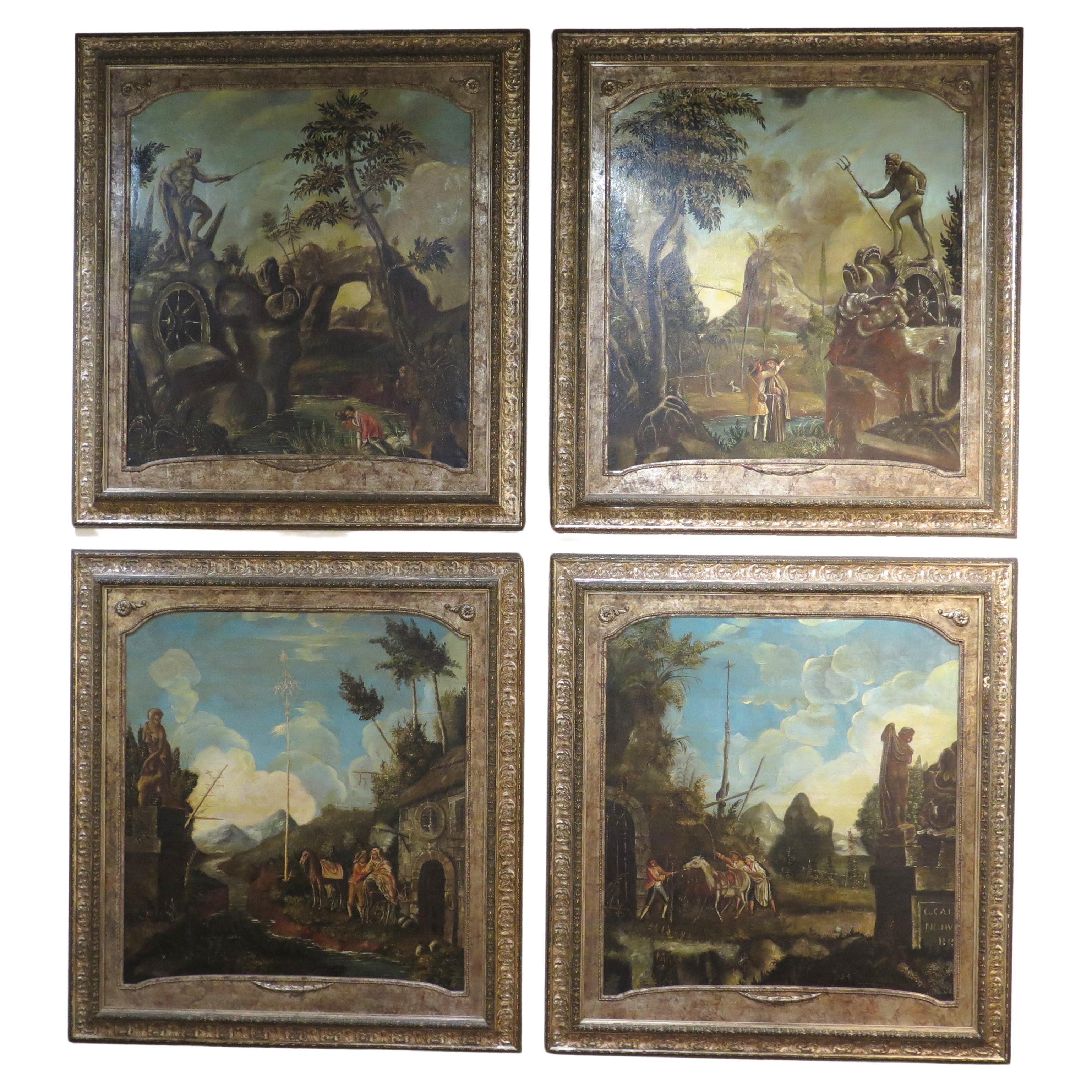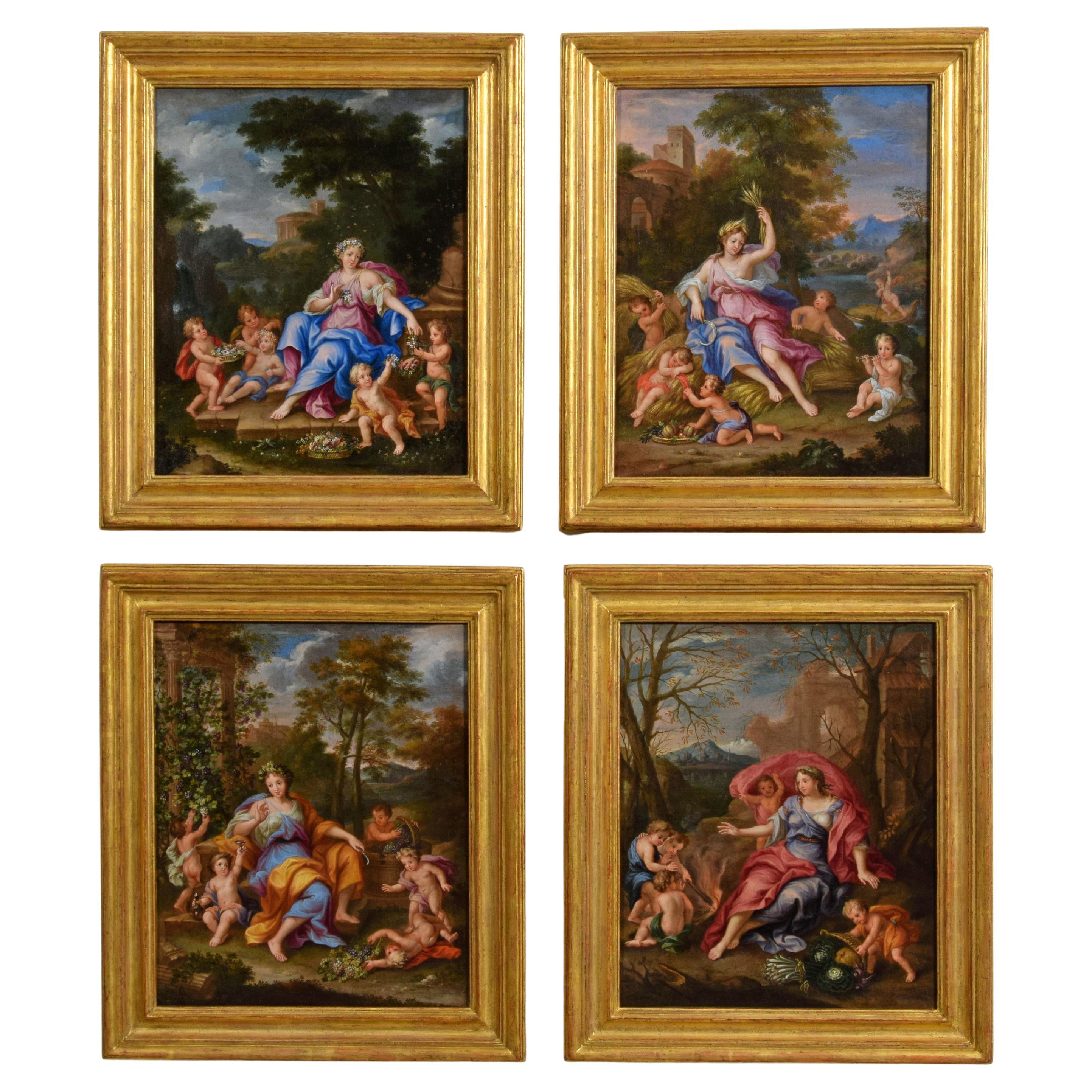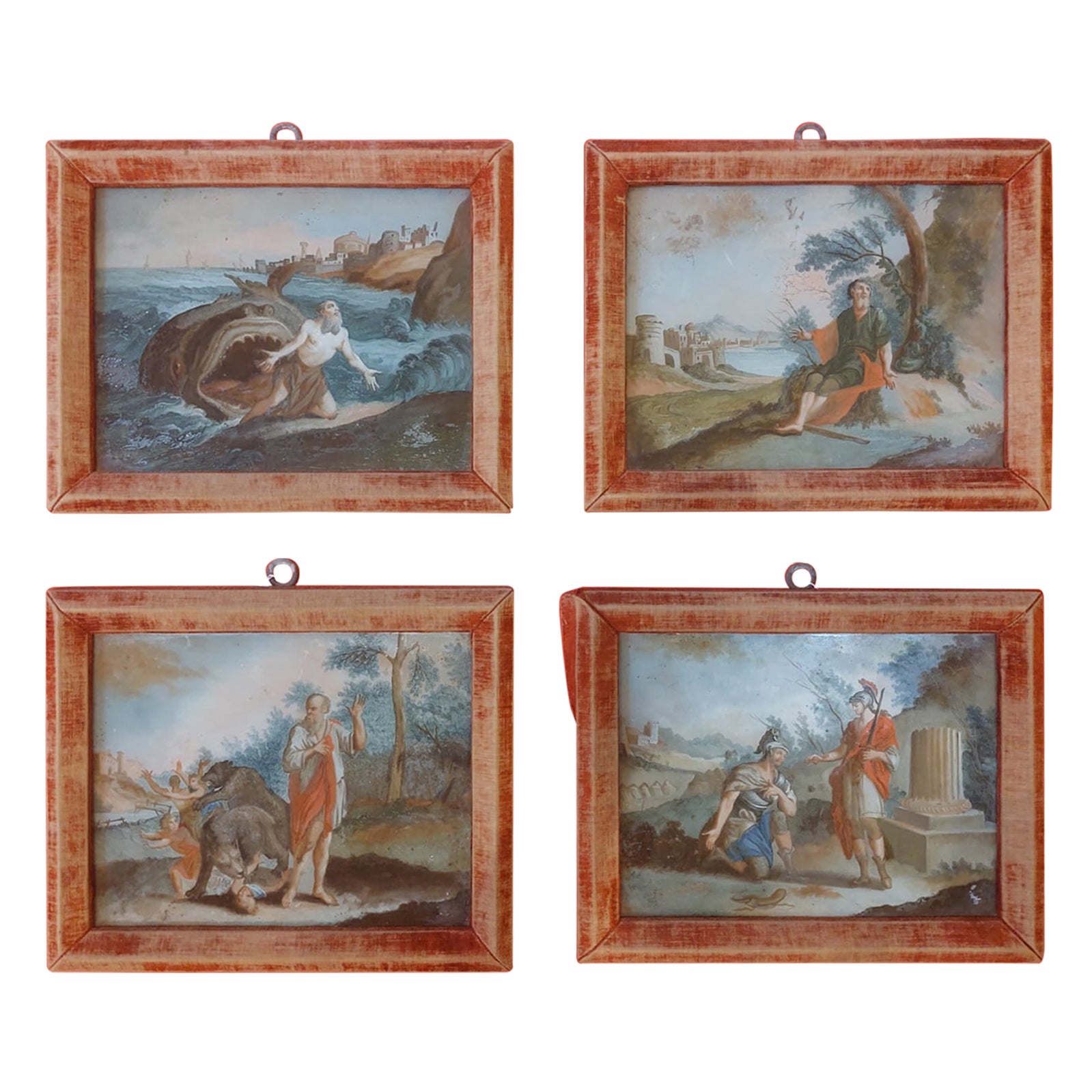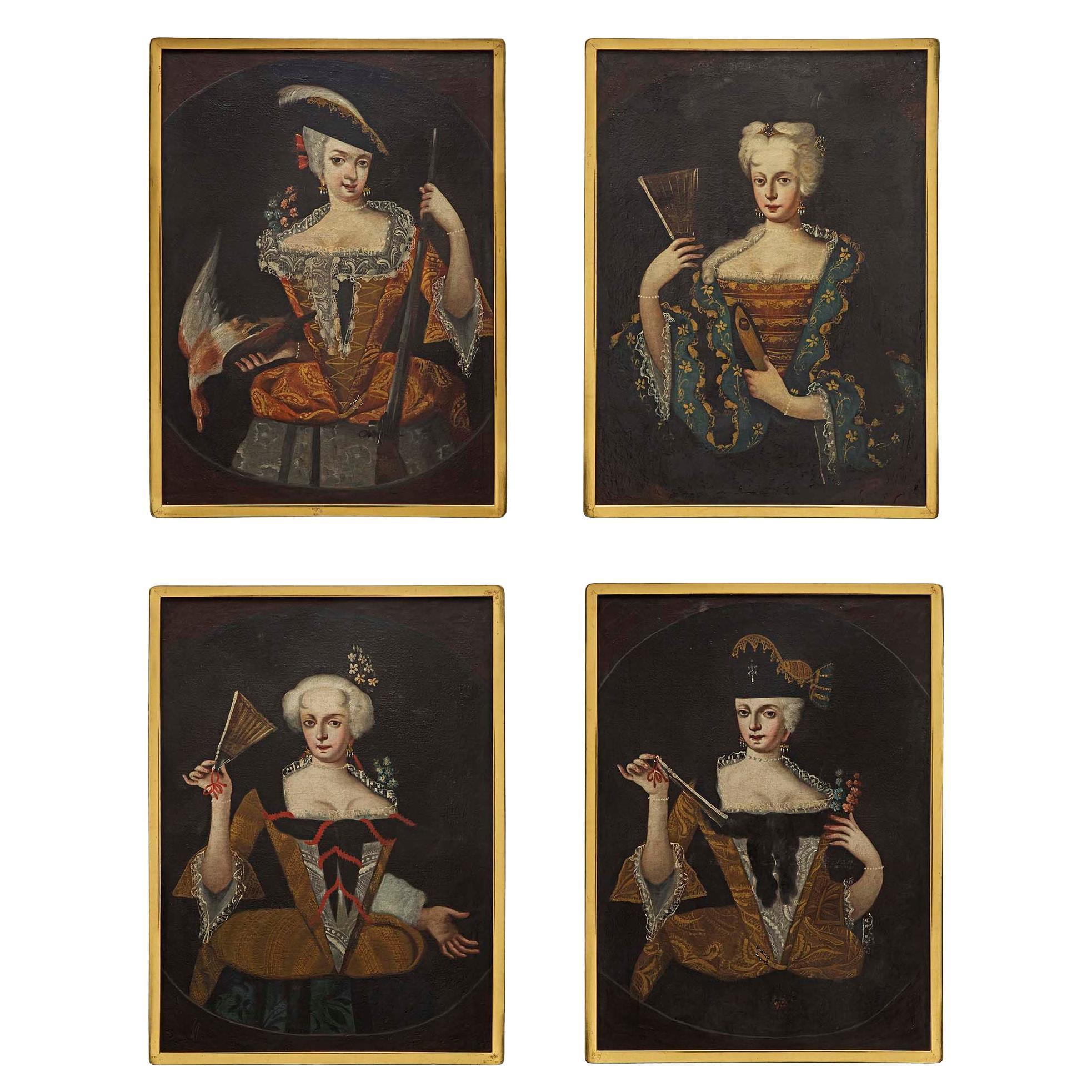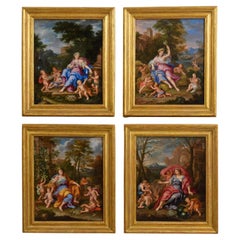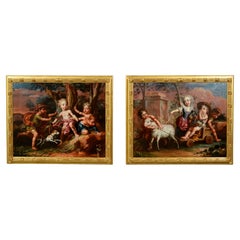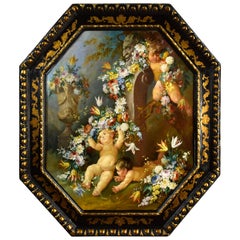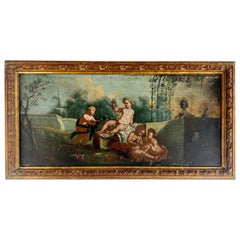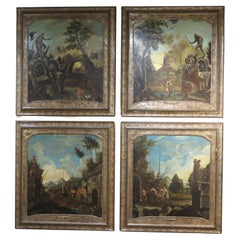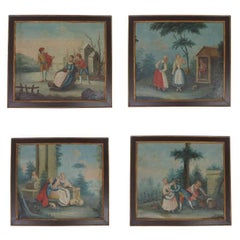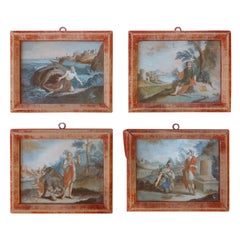Items Similar to 19th Century Four Italian Oil on Panel with Allegory of the Four Elements
Want more images or videos?
Request additional images or videos from the seller
1 of 17
19th Century Four Italian Oil on Panel with Allegory of the Four Elements
$4,313.32
£3,210.98
€3,600
CA$5,908.17
A$6,571.17
CHF 3,431.26
MX$79,964.15
NOK 43,822.44
SEK 41,097.71
DKK 27,405.54
Shipping
Retrieving quote...The 1stDibs Promise:
Authenticity Guarantee,
Money-Back Guarantee,
24-Hour Cancellation
About the Item
19th century four Italian oil on panel with allegory of the four elements
Dimensions with frame: cm H 34.5 x L 25; only the table: cm H 29 x L 20.5
The funny oil on panel, by an artist active in Piedmont, in the north of Ital, in the first half of the 19th century, represent the allegory of the four elements of the Earth.
They are inspired by the group of four etching prints of circa 1730, made to a design by Rococo painter Jacopo Amigoni (Naples 1682- Paris 1752) and engraved in Venice by Joseph Wagner (Gestratz, 1706 – Venice, 1780).
Each painting represents the allegory of an element: the earth, the fire, the water and the air.
The land is represented by a young couple in a rural environment; the young man, accompanied by a dog, offers a bouquet of flowers to the girl. The fire is represented by a burning building from which flees the couple who were preparing for a picnic, as suggested by the wicker basket with pottery that the boy supports. The element of water is remembered by fishing: while a young woman is busy fishing, a boy gives her a gift of fish caught with a net. The air is symbolically remembered by the flight of birds: in the painting you see a young man on a ladder resting on a tree takes a bird and gently hands it to the girl, ready to welcome him in the fabric of her dress.
The four paintings reproduce the archaic taste widespread in the eighteenth century, in which the classic and simple pastoral poetry was celebrated, through the recovery of the myth of Arcadia. The Earth becomes a source of peace and serenity, a place of the soul, in which man lives in perfect harmony with Nature. The world of contemporary living rooms moves into small woods and rural environments, set by shepherds and shepherds.
The works, in a good state of conservation, are characterized by a marked decoration and pleasantness of the subject.
Articles accompanied by a "Certificate of Authenticity".
- Dimensions:Height: 13.78 in (35 cm)Width: 9.85 in (25 cm)Depth: 0.79 in (2 cm)
- Style:Rococo (In the Style Of)
- Materials and Techniques:
- Place of Origin:
- Period:
- Date of Manufacture:19th Century
- Condition:
- Seller Location:IT
- Reference Number:1stDibs: LU4405218011362
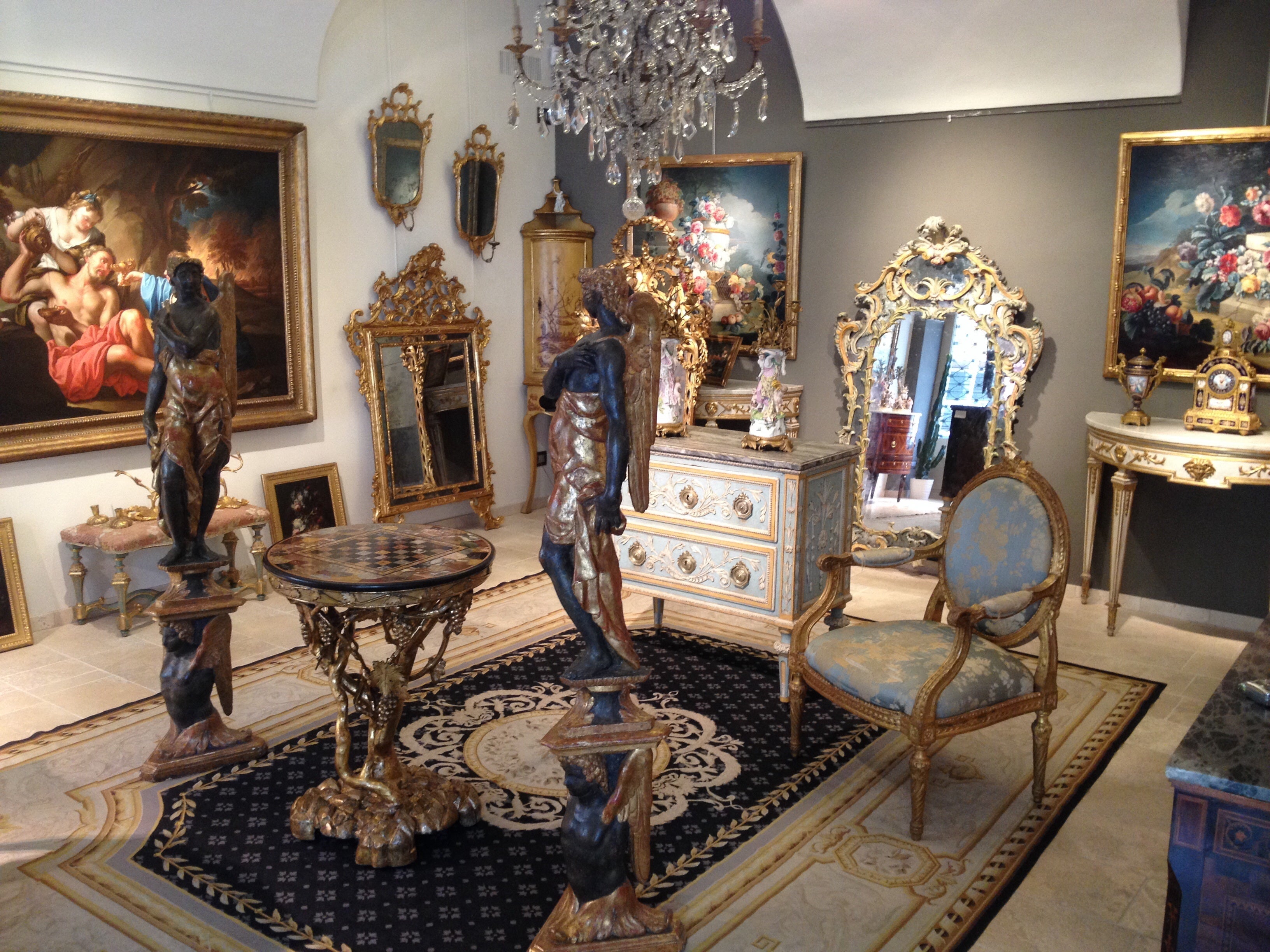
About the Seller
5.0
Platinum Seller
Premium sellers with a 4.7+ rating and 24-hour response times
Established in 1980
1stDibs seller since 2019
56 sales on 1stDibs
Typical response time: 1 hour
- ShippingRetrieving quote...Shipping from: Italy
- Return Policy
Authenticity Guarantee
In the unlikely event there’s an issue with an item’s authenticity, contact us within 1 year for a full refund. DetailsMoney-Back Guarantee
If your item is not as described, is damaged in transit, or does not arrive, contact us within 7 days for a full refund. Details24-Hour Cancellation
You have a 24-hour grace period in which to reconsider your purchase, with no questions asked.Vetted Professional Sellers
Our world-class sellers must adhere to strict standards for service and quality, maintaining the integrity of our listings.Price-Match Guarantee
If you find that a seller listed the same item for a lower price elsewhere, we’ll match it.Trusted Global Delivery
Our best-in-class carrier network provides specialized shipping options worldwide, including custom delivery.More From This Seller
View All17th century, Four French Paintings Depicting The Seasons, Circle of Noel Coypel
By Noël Coypel
Located in IT
Four paintings depicting the seasons, circle of Noel Coypel, second half of the 17th century
Oil on canvas
Measures: cm W 37 x H 46 x D 2 cm (canvas)
The four paintings, presented in...
Category
Antique Late 17th Century French Baroque Paintings
Materials
Canvas
18Th Century, Pair of Italian Allegory Paintings By Vittorio Amedeo Rapous
By Vittorio Amedeo Rapous
Located in IT
18Th Century, Pair of Italian Allegorical Paintings By Vittorio Amedeo Rapous
Pair of paintings depicting the Allegory of Spring with putti and the Allegory of Autumn with putti, Vi...
Category
Antique Late 18th Century Italian Rococo Paintings
Materials
Canvas
$36,423 Sale Price
20% Off
19th Century, Italian Painting with Still Life with Cherubs
Located in IT
19th century Roman painter
Still life with cherubs, flower festoons and herma with faun
Measures: Oil on canvas, cm H 78 x W 95 without frame
Cm H 122.00 x W 106 x D 8 with frame.
The work, painted in oil on canvas, octagonal in shape, represents a nature with three putti or cupids playing with flower festoons in a wooded environment in which is placed a herma with faun and, on the left, a large neoclassical marble vase...
Category
Antique 19th Century Italian Baroque Paintings
Materials
Canvas
18th Century, Italian Painting Depicting Landscape with Watermill and Characters
Located in IT
18th century, Italian painting depicting landscape with watermill and characters
Oil on canvas; Measurements: frame cm L 103.5 x H 127 x P 5; painting L 93 x H 117.5
The painting...
Category
Antique Mid-18th Century Italian Rococo Paintings
Materials
Canvas
18h Century, Four Italian Etching Allegory of the Four Seasons
By Giovanni Volpato 1
Located in IT
18h Century, Four Italian Etching Allegory of the Four Seasons
Allegory of the Four Seasons, engraved by Giovanni Volpato and drawn by Francesco Maggiotto...
Category
Antique 1770s Italian Neoclassical Prints
Materials
Canvas, Walnut, Paper
17th Century, Italian Painting by Pier Francesco Cittadini, Jacob and his Family
Located in IT
Pier Francesco Cittadini (Milan, 1616-Bologna, 1681)
"Jacob and his family go to Egypt"
Oil on canvas, cm 109 x 190 (canvas only)
The valuable painting, made in oil on canvas, depicts Jacob and his family go to Egypt and we believe it can be, given the high quality painting, autograph work of Italian Pier Francesco Cittadini (Italy Milan, 1616 - Bologna, 1681) made after 1647. The work, in excellent condition is accompanied by a coeval frame in wood finely carved and golden.
The scene depicted, which was confused with the Flight to Egypt in the past years, is instead identified with the biblical episode of Jacob’s journey. In the foreground, reading the painting from left to right, we see a caravan composed of animals, including donkeys, dromedaries, goats, dogs and horses and people, women, men and slaves, who carry on their journey along the banks of a river, following a path that to the right, would seem to lead to the through of a bridge. In addition to the watercourse is described an environment characterized by large rocks and impervious come far to cover the entire verticality of the canvas. On the left, in the distance, we see the tail of the caravan that runs along the steep path. Large trees enliven and harmonize the environment, as well as white and grey clouds characterize the predominantly clear sky and illuminated on the right by sunlight.
The story is told in the Bible, Book of Genesis, 30, 25, passage in which is described the flight of Jacob from Haran after the contrasts with Laban, father of his wife Rachel. Jacob is the third great patriarch of the Bible. From his descendants originate the twelve generations of the people of Israel. He is the son of Isaac and Rebekah, who led him to flee from the wrath of Esau to Haran to seek refuge from his brother, Laban. At his uncle’s house Jacob met his daughter Rachel. As soon as he saw his cousin, Jacob was taken. Jacob will stay seven years in the service of Laban to marry his beloved Rachel. But Laban, with a deception, will give him in marriage first Lia, the least beautiful eldest daughter, and only after another seven years the splendid Rachel. From his first wife he will have several children, while Rachel will give birth to the beloved son, Joseph, who will become viceroy of Egypt.
After years of service, Jacob asked to be paid with every dark-coloured garment among the sheep and every spotted and dotted garment among the goats. Laban accepted and sent away from his sons all the leaders of that kind. So Jacob took fresh branches of poplar, almond and plane tree, and flayed them, and put them in the troughs. The optical suggestion induced the goats and the sheep to conceive and give birth to dark, striped and dotted garments. He also ensured that all the strongest and healthiest leaders of the flock of Laban would drink near the barked branches, thus assuring a genetic superiority to his part of the flock. His flocks grew numerous and strong and he became richer than his relative, arousing envy. It was clear that Laban would not respect him much longer. At the suggestion of the Lord, Jacob decided to return to Canaan. Trying to avoid any possible dispute, he left with his family while Laban was absent for shearing sheep. But when, three days later, his uncle returned home, he became angry, feeling offended because Jacob had gone secretly and had not allowed him to greet his daughters and grandchildren. In addition, his teraphim, statuettes, or idols, which depicted the family deities, had disappeared. After 7 days of pursuit, Laban and his men reached Jacob’s group on Mount Gilead, in the mountainous region west of the Euphrates River, where his uncle and grandson had a stormy conversation. The younger man was outraged at being accused of stealing idols and told Labano to rummage through his family’s tents at will. Neither of them could know or even imagine that it was Rachel who took the idols and hid them in the saddle of the camel. During the search, she sat down firmly on the saddle, apologizing for not being able to get up, «because I usually have what happens to women» (Gen 31:35). So the loot wasn’t discovered.
The author of this work was inspired by the composition of an engraving by Stefano Della Bella (1610-1664) of circa 1647. The engraving by Stefano della Bella bears the title "Iacob sur ses vieux jours quitte sans fascherie pour voir son filz Ioseph, sa terre et sa patrie" and is signed on the bottom left "Stef. of the Beautiful In. et fe." while on the right it is declared "Cum privil. Regis", that is with license of the king.
Stefano Della Bella (Italy - Florence, May 18, 1610-Florence, July 12, 1664) was born in a family of painters, sculptors and goldsmiths and was left early orphan of his father sculptor, he dedicated himself first to the art of goldsmith at the school of Giovanni Benedetto Castiglione and Gasparo Mola, then turning his attention to drawing and engraving. He soon began drawing figures and copying the etchings of Jacques Callot, which inspired his early works. Under the protection of the Medici, in particular of Don Lorenzo, cadet son of Grand Duke Ferdinand I, Della Bella has the opportunity to make study trips to Rome, where he stayed from 1633-1636; In Rome he met French engravers and publishers of prints such as Israël Henriet and François Langlois, who influenced his decision to move to Paris in 1639, four years after the death of Callot. In Paris he soon reached, thanks to the engravings commissioned by Cardinal Richelieu, the success also worldly; he frequented courtiers, theatre artists and writers, while refusing too oppressive honors. In 1646-1647 he continued his travels in the Netherlands to Amsterdam, Antwerp and Dordrecht. He returned to Florence in 1650 and resumed working under the protection of the Medici court, working for his patrons. In 1656 he became a member of the Academy of Apatists.
The painting object of this study is reasonably attributable to Pier Francesco Cittadini, or Pierfrancesco Cittadini, called the Milanese or the Franceschino (Italy - Milan, 1616-Bologna, 1681) as some exemplary stylistic comparisons proposed to follow can prove.
Pier Francesco Cittadini was an Italian baroque painter, mainly active in Bologna.
His artistic training first took place with the painter Daniele Crespi...
Category
Antique Mid-17th Century European Baroque Paintings
Materials
Canvas, Giltwood
You May Also Like
19th C. Italian Oil on Canvas w/ Cherubs
Located in Los Angeles, CA
19th C. Original Oil on Canvas depicting a group of cherubs making flower garlands. It is charming and whimsical. The detail is intricate. It has been relined and a has had a gilt...
Category
Antique 19th Century Italian Rococo Paintings
Materials
Canvas, Paint
$1,800 Sale Price
35% Off
A Set of Four Late 18th Century / Early 19th Century Allegorical Paintings
Located in Dallas, TX
A set of four (4) Late 18th Century / Early 19th Century allegorical paintings amongst landscapes amongst classical ruins, relived frames contemporary pictures most likely. Italian.
...
Category
Antique Early 18th Century Italian Neoclassical Decorative Art
Materials
Canvas
18th Century Romantic Italian Paintings
Located in Palm Beach, FL
Here is a set of four 18th century Italian paintings depicting various romantic dramas. All four painted in old world style and presented in the original stretchers and frames. Findi...
Category
Antique 18th Century Italian Romantic Paintings
Materials
Paint
$12,500 / set
Four Neapolitan underglaze paintings with frame
Located in Milano, IT
The four 18th-century Neapolitan posthumously framed under-glass paintings depict biblical scenes from The Book of Jonah, specifically:
1. Jonah vomited by the Whale;
2. Elisha and t...
Category
Antique 18th Century Italian Baroque Paintings
Materials
Glass, Wood
$7,188 / set
Set of Four Continental 18th Century Collection of Whimsical Paintings
Located in West Palm Beach, FL
A Continental 18th century whimsical collection of charming paintings depicting Ladies of the 18th century. The set of four paintings is meant to...
Category
Antique 18th Century Unknown Paintings
Materials
Canvas, Giltwood
Set of 3, 19th Century Allegorical Reverse Glass Paintings
Located in Atlanta, GA
**Set of 3, 19th Century Allegorical Reverse Glass Paintings**
This captivating set of **three 19th-century allegorical reverse glass paintings** presents richly detailed narratives imbued with symbolism and classical themes. Each painting is executed in the traditional reverse glass technique, providing a smooth and reflective surface that enhances the vibrant palette and fine detailing.
1. **Painting 1 (Left Panel):**
This scene portrays a dramatic encounter, likely a moment of judgment or persuasion, set against a distant landscape. A figure in a flowing blue robe gestures emphatically toward a well-dressed couple, perhaps symbolizing conflict, intervention, or moral decision-making. The background includes a sweeping view of the countryside, with figures in the distance adding depth and context.
2. **Painting 2 (Center Panel):**
The central panel features a pastoral scene steeped in allegorical significance. A central figure dressed in red, resembling a shepherd, commands attention under a radiant sunburst. Surrounding characters appear in moments of tension and repose, including a reclining figure and a soldier-like character. This composition evokes themes of guidance, struggle, and divine providence, with the bright sky and natural elements reinforcing the allegorical tone.
3. **Painting 3 (Right Panel):**
The final panel depicts an intimate interior scene, with two seated women engaged in conversation, one gesturing emphatically as a standing male figure observes. The setting includes detailed furnishings, such as a writing desk, a red draped curtain, and objects hinting at scholarly or domestic pursuits. This tableau may represent themes of wisdom, counsel, or moral reflection, supported by the characters' thoughtful expressions and elaborate dress.
Each painting is framed in its **original dark wooden frame**, complementing the vibrant colors and enhancing their display value. The set embodies the **19th-century European fascination with allegory and storytelling**, making it a significant piece for collectors of reverse glass art...
Category
Antique Mid-19th Century Italian Baroque Paintings
Materials
Glass, Paint
$1,036 Sale Price / set
20% Off
More Ways To Browse
Italian Pottery 19th
Italian Rococo Painting
Girl With Dog
Rococo Wall Panel
Picnic Table
Sets Of Framed Bird Prints
Picnic Set
Hand Painted Antique Italian Pottery
Shepherd Table
Rococo Fire Basket
Shepherd Boy
Antique Picnic Basket
Antique Picnic Baskets
Fire Ladder
Naples Pottery
Wicker Fish
Italian Pottery Dog
Painters Ladder
